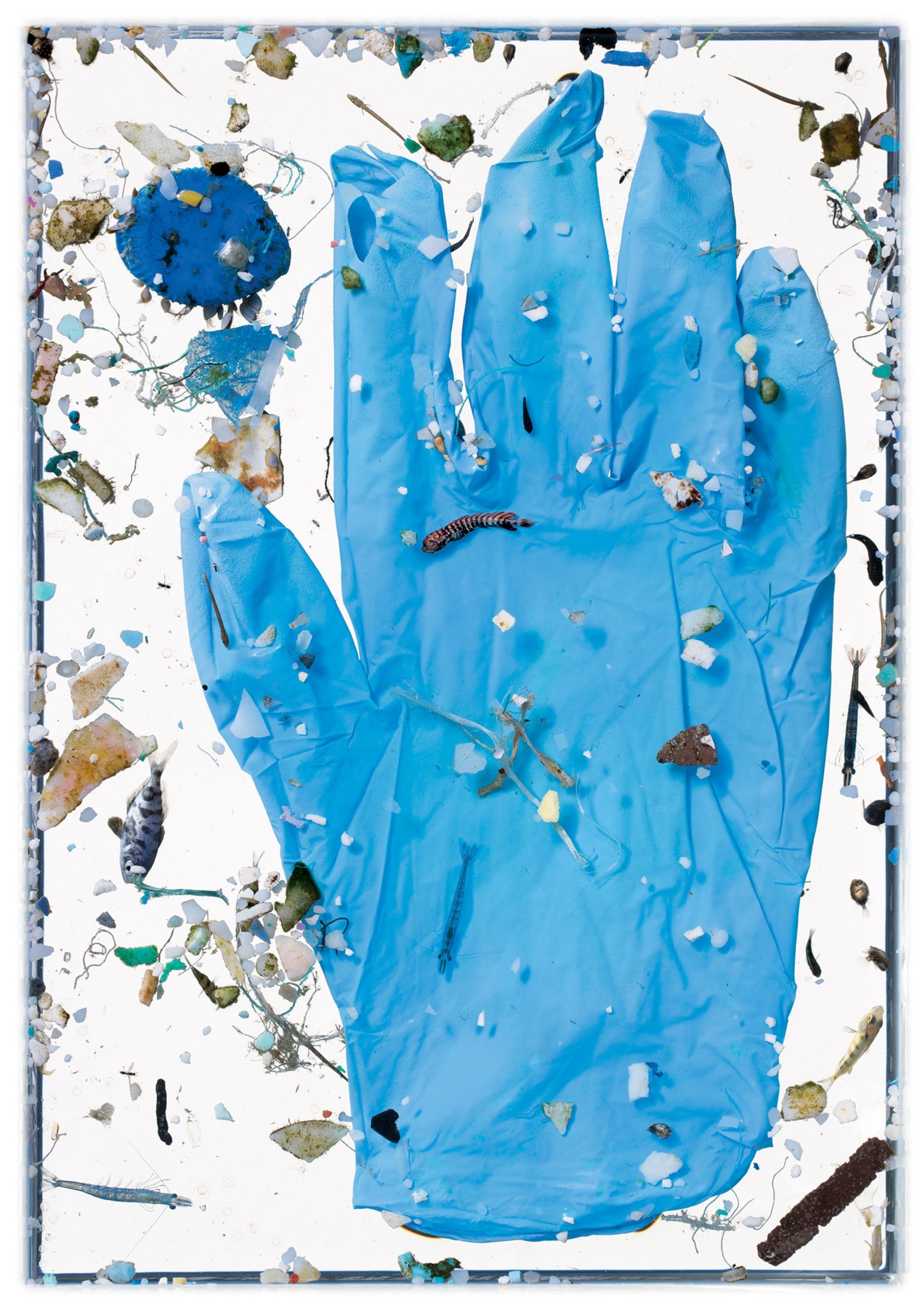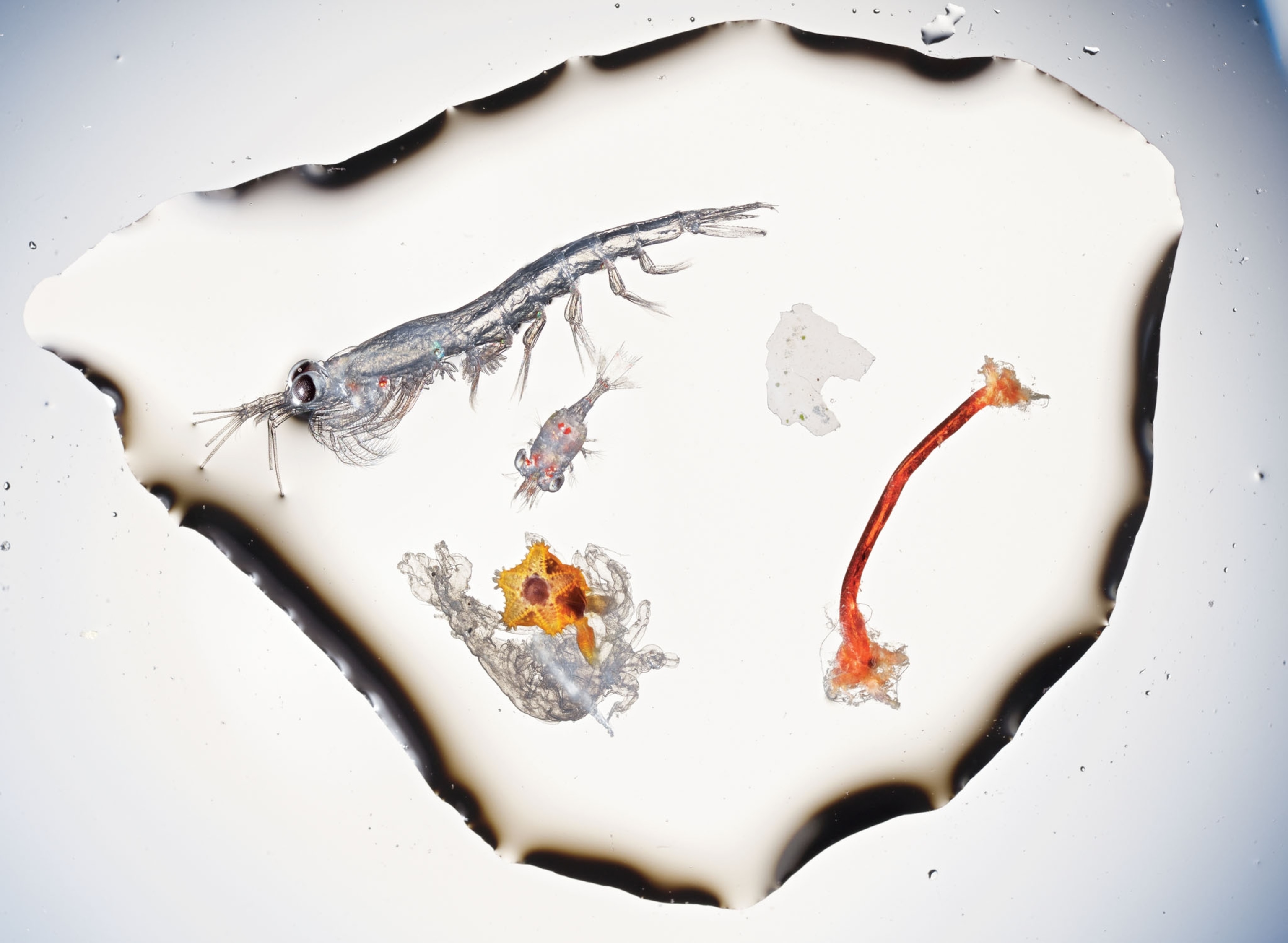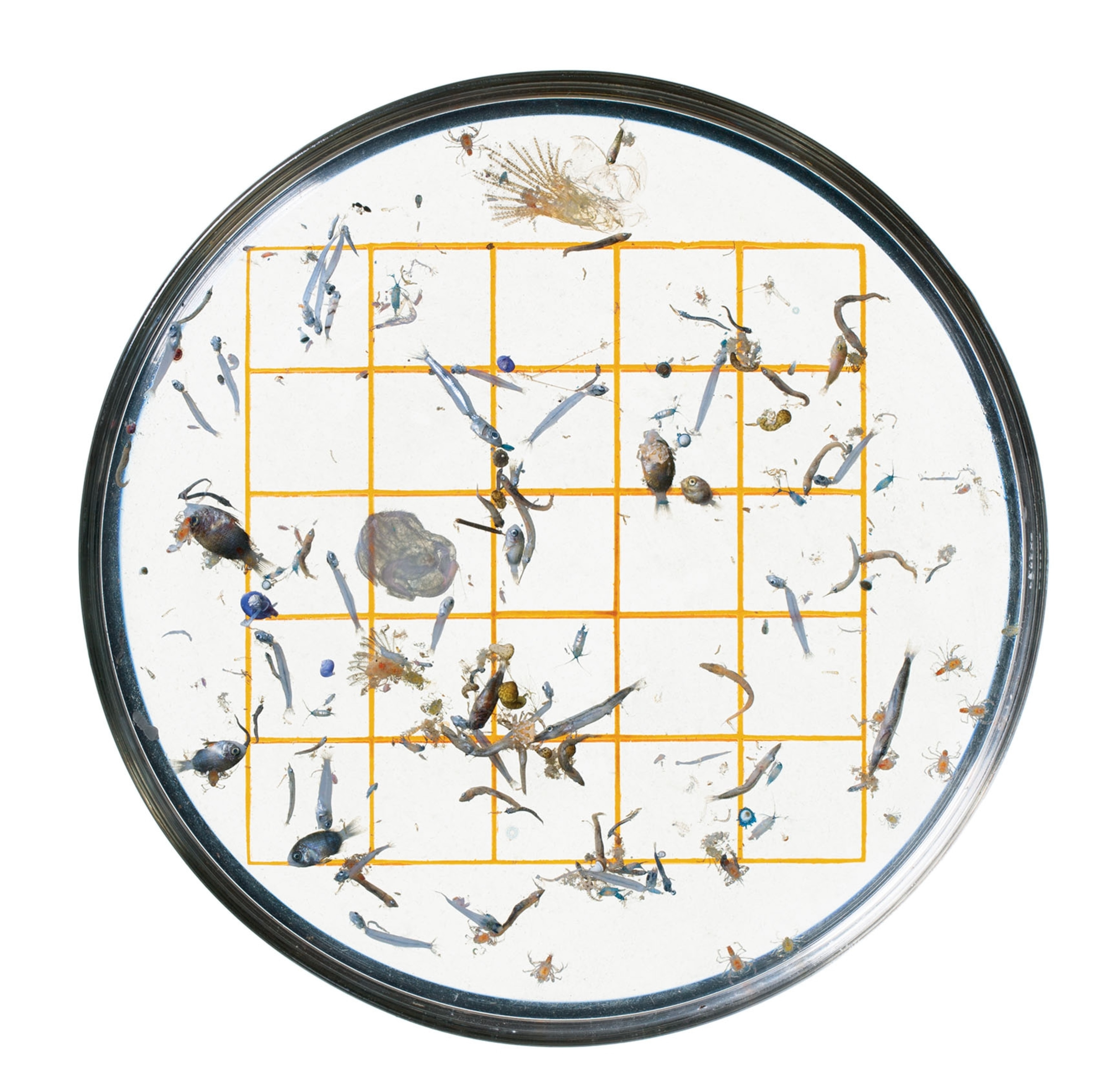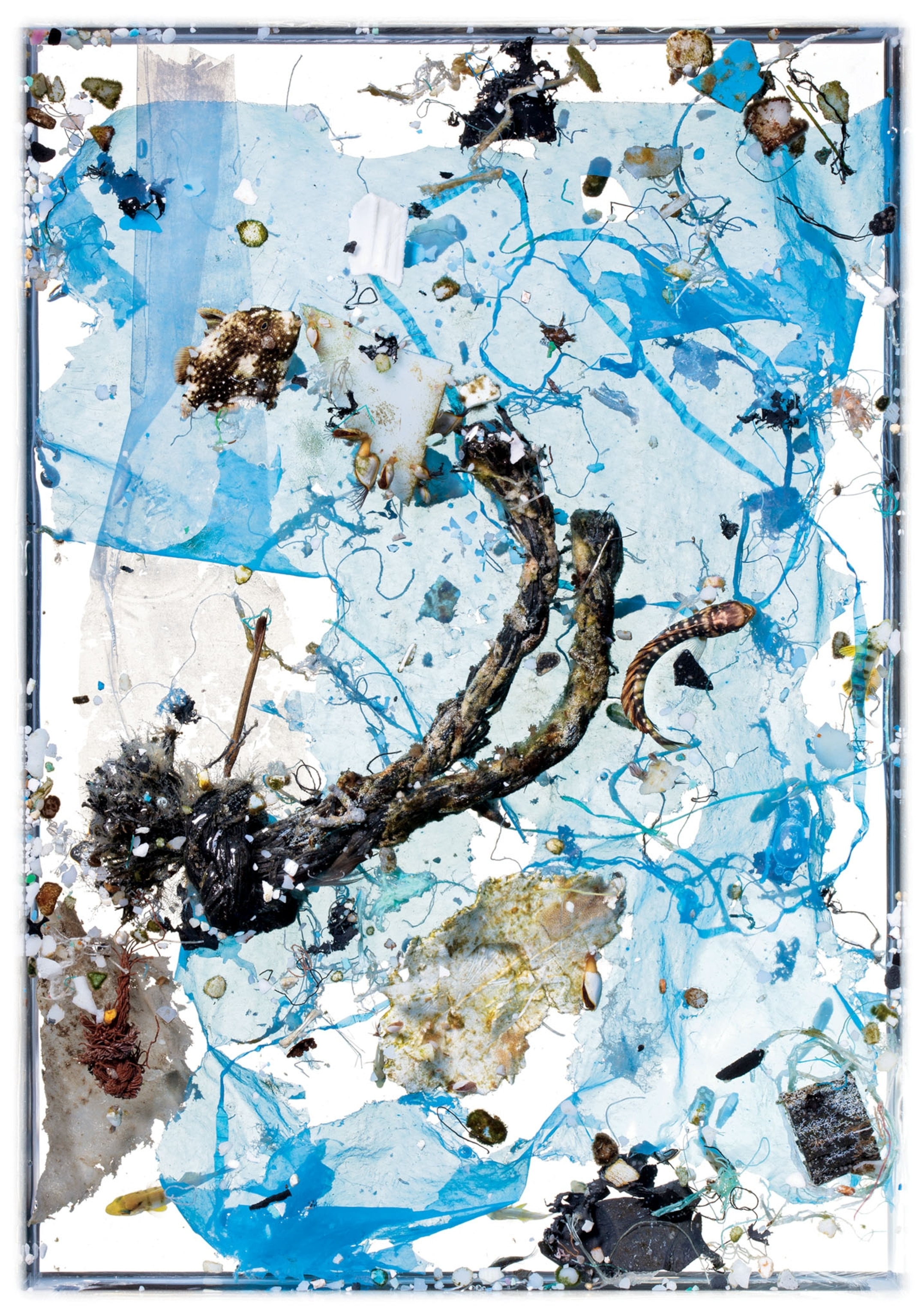
Baby fish have started eating plastic. We haven’t yet seen the consequences
Newborn fish are mistaking tiny bits of trash for food. If they die, there’ll be fewer big fish—and that could rattle the food chain.
This story appears in the May 2019 issue of National Geographic magazine.
Not long ago I went snorkeling in the Pacific Ocean, a half mile off the southwest coast of Oahu. The flanks of the Hawaiian island are steep there, and the bottom quickly disappeared beneath us as we motored out to the site. Looking back, I could see the green slopes of the Waianae Range rising to 4,000 feet behind the beach. Normally the mountains shield the water here from the trade winds. But on that day a breeze created a light chop that nearly obscured what I had come to see: a thin, oily slick of surface water, rich in organic particles, in which newborn fish were feeding and struggling to survive their first precarious weeks.
Plunging my face into the sheen, I found myself looking inside a fish nursery: The water was dotted with life you would ordinarily never notice. Fish eggs drifted like tiny lanterns, their yolk sacs glowing in the sunlight. Fish larvae small as ladybugs darted about. A sergeant major damselfish the size of a dime appeared huge by comparison as it fluttered past. Below us, a school of 12-inch, bigeye scad—like mackerel but with enormous eyes—fed on everything that had the misfortune of being small.
My guides that day, oceanographer Jamison Gove and fish biologist Jonathan Whitney of the National Oceanic and Atmospheric Administration in Honolulu, are nearly three years into a research project that aims to make sense of this chaotic scene. The larval stage is the “black box” of fisheries science: Fertilized eggs go in, and young fish come out—but what happens inside remains sketchy. The larval fish are so small and fragile they’re exceedingly difficult to study. The overwhelming majority will never become adults. Yet fish populations around the world, and the animals that eat them, depend on just how many larval fish make it, and in what condition.

What Gove and Whitney have found lately—and what David Liittschwager’s photographs of their water samples document—is that fish and wholesome fish food are not the only things collecting in the slicks off Hawaii. Microplastics, tiny shreds of human trash, are there as well, and in such abundance that larval fish are eating them in their first days of life.
For newborn fish, to eat is to live another day; if their first meal is plastic, they’re not consuming the calories they need to sustain them until the second. “They’ve beaten a lot of odds to get this far,” Gove says. “They hatched, they found the slick, they’re feeding and growing. This is one-tenth of one percent that made it this far; they’re the lucky ones. And now plastics are coming in.”
“The most critical moment is that first feeding,” Whitney says. “If they get a piece of plastic, that could be it. A single thread in the stomach of a larval fish is potentially a killer.”

Plastic waste, mostly from rivers or careless dumping on land, washes into the oceans at an average rate of about nine million tons a year, according to a 2015 study by Jenna Jambeck of the University of Georgia. The visible trash, along with heartbreaking images of its impact on everything from turtles to birds to whales, has generated a public outcry. But sunlight, wind, and waves eventually break down ocean plastic to bits that are barely visible. One of the biggest unknowns—and concerns—is the effect that these microplastics, smaller than a fifth of an inch, might be having on fish.
Fish provide critical protein to nearly three billion people and countless seabirds and other marine animals. But fish stocks worldwide have fallen by half since 1970, surveys show. Populations of the largest predatory fish, such as tuna, have fallen even more. The decline is largely because of overfishing, but pollution and waters warmed and acidified by climate change are having a growing impact.
As long ago as the early 1970s, scientists were finding plastic pellets—the material used to manufacture plastic goods—in the stomachs of fish caught off New England and Great Britain. More recent studies have documented the presence of even smaller microplastic particles in a growing array of adult fish. Larval fish have been studied much less but are likely to be more vulnerable to microplastics, as they are to everything else. “Any stressor will likely have more of an impact on early life stages than later life stages,” says Susanne Brander, a toxicologist at Oregon State University who is studying how plastics might affect the growth of fish.

Most ocean fish are terrible parents. A few species guard their eggs on the seafloor; others protect them inside their mouths. But most fish release thousands or even millions of eggs and sperm into the wide ocean and never see their offspring. When eggs hatch a day or two later, they’re on their own.
Newly hatched fish look misshapen, heads oversize, tails barely formed. They have to eat like crazy to grow into their body. Whereas human babies develop in the shelter of the uterus, fish mainly develop after they emerge into an unforgiving world.
“They hatch super early,” Whitney says. “They have small brains; some fins aren’t even formed. Their liver isn’t fully developed. Or their hearing or seeing. They are only partially developed, but they are actively swimming, eating, fending for themselves.”
Predators or starvation will get most of them. “That’s why fish spawn so many eggs,” says Su Sponaugle, an Oregon State University marine ecologist who specializes in the early life stages of fish. “They have to hedge their bets.”
The larval phase is treacherous every step of the way—starting with the need for the larvae to find food, which they do in a surface slick. Surface slicks form mostly in coastal regions around the world, wherever currents, tides, or subsurface waves cause water to converge and concentrate the organic gunk that floats in it. Slicks can be seen by satellite as long, squiggly ribbons that run parallel to coasts.
Some larval fish swim to slicks, some drift, as do eggs not yet hatched. Predators converge on slicks too. If a baby fish manages to avoid being eaten and to find enough food, it will be about two inches long when it heads back to its permanent habitat—a reef, say. The right current will transport it there, the wrong one out to sea.
“If you miss an island, good luck with that. If there’s no reef, you cannot complete your life cycle,” Sponaugle says. Life for larval fish was a crapshoot even before they met our plastic trash.
Off Hawaii, a single eight-minute tow of the NOAA team’s net yields a plethora of living organisms and plastic.
Pushed into a surface slick by converging currents, they’re separated in the lab by a technician with tweezers. A computer program counts the plastic pieces and measures each one; the technician uses a microscope to identify the creatures.


Whitney and Gove came to ocean science and Hawaii by happenstance. Whitney, 37, grew up in New Jersey with a kid’s plan to become a veterinarian. He arrived in Honolulu in 2006 as a volunteer for a census of humpback whales. In graduate school he worked his way down to the tiniest organisms of the sea.
Gove, 40, grew up in San Diego and learned to surf before he could read. A summer job with NOAA convinced him the ocean was more than a playground. After helping to cut 70 tons of abandoned fishing gear from Hawaiian coral reefs, Gove enrolled in graduate school to become an oceanographer. He specialized in how winds, tides, and waves affect ocean ecosystems and surface slicks in particular.
Slicks are transient—they break up in rough weather—which makes studying them a challenge. Gove and Whitney took me to see a slick off Oahu because it was close to their lab, but their main research site is on the west side of Hawaii, the Big Island, where two large volcanoes provide an even better wind shadow than Oahu’s Waianae Range. The steep drop-off of the seafloor has proved to be a surprise bonus: The slicks attract an oceanic convention of not only reef fish but also fish from greater depths, including commercially important mahi-mahi, swordfish, and marlin.
“One of the coolest things we found was the diversity,” Whitney says. “We’ve got deep-sea fish, mid-ocean fish, and reef fish, all interacting at the surface for the first few weeks of their lives. It was incredibly unique. I can’t think of any other place on Earth where babies from different areas share nursery grounds.”
He and Gove expected to find plastics in their slicks; the Hawaiian chain is in the drift pattern of the Great Pacific Garbage Patch. But they never intended to join the growing hunt for microplastics that has overtaken the work of so many marine scientists. Their focus was basic research on larval fish. Their samples contained such loads of plastic, however, that they had to revise their project.
The preliminary results indicate that slicks concentrate plastics even more than they do larval fish. In the water outside slicks, Whitney and Gove found nearly three times more larval fish than microplastics. Inside slicks, the situation was reversed: Microplastics outnumbered larval fish by more than seven to one. On average there was almost 130 times as much plastic inside slicks as outside.
“We didn’t have any idea we would find such concentrations,” Gove says. One of the first fish they dissected had plastic in its gut.

What harm such plastic is causing is still unsettled science. But in lab tests, some clues have emerged. Plastic reduces the appetites and growth rates of fish that consume it. That could affect reproduction and ultimately population size. “The larger a female fish is, the more eggs she can carry and the higher number of offspring she can produce,” Brander says.
In their lab, Whitney and Gove oversaw the dissection of more than 650 larval fish, most of them between one-third of an inch to half an inch in length. They found plastic in 8.6 percent of the ones caught in slicks. That doesn’t sound like much, and outside slicks the percentage was less than half that—but scientists know that small changes in the survival of larval fish can translate into large changes in fish populations, with cascading effects up the food chain.
The NOAA researchers found tiny blue strands of polyethylene and polypropylene, commonly used to make fishing gear, in the stomachs of larval swordfish, marlins, and five other species. The strands look a lot like the food that larval fish crave: tiny copepods, bluish crustaceans with long, skinny antennae.
In larval mahi-mahis, Whitney and Gove found no plastic. They’re not sure why. Was it because eyesight develops earlier in mahi-mahis, making them better than other species at distinguishing plastic from prey? Or was it because the mahi-mahis that ate plastic had died and escaped detection?
Flying fish appear to eat plastic especially frequently. Besides serving as prey for larger fish, including sharks, flying fish are primary prey for 95 percent of Hawaiian seabirds. Are birds ingesting plastic with their flying fish, and is that affecting them? For every question the researchers answer, Gove says, 10 new ones come up.
The smallest fish he and Whitney found with plastic in its stomach was just a quarter inch long, about six millimeters. But the plastic fibers the fish are eating are smaller.
“They are less than one millimeter, things you can barely see with the naked eye,” Whitney says. That is “the shocking part: The pieces we can’t even see are the problem.”
The nonprofit National Geographic Society, working to conserve Earth’s resources, helped fund this article.
The National Geographic Society and Sky Ocean Ventures have launched the Ocean Plastic Innovation Challenge, which asks problem solvers around the globe to develop novel solutions to tackle the world’s plastic waste crisis. Have an idea? Submit your solution by June 11 at oceanplastic-challenge.org.








